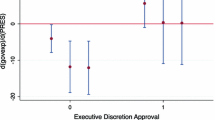Abstract
We test implications of politicalcompetition theory concerning government size, usingdata from U.S. states. We find that greaterpolitical competition in the race for governor actsas a check against bigger government. Evidence onthe effectiveness of legal limits on expendituresand/or revenues growth is mixed. The DemocraticParty is associated with bigger government, but onlywhen party representation in both the governor'shouse and the legislature is strong. The flypapereffect of grants is found to be strong. Our resultshave implications for models of fiscal illusion.
Similar content being viewed by others
References
Advisory Commission on Intergovernmental Relations (1993).Significant features of fiscal federalism, Volume 2 (Revenues and expenditures), Washington, DC.
Advisory Commission on Intergovernmental Relations (1993). Significant features of fiscal federalism, Volume 1 (Budget processes and tax systems), Washington, DC.
Alt, J.E. and Lowry, R.C. (1994). Divided government, fiscal institutions, and budget deficits: Evidence from the states. American Political Science Review 88: 811–828.
Baber, W.R. and Sen, P.K. (1986). The political process and the use of debt financing by state governments. Public Choice 48: 201–215.
Barro, R. (1979). On the determination of the public debt. Journal of Political Economic 87: 940–947.
Besley, T. and Case, A. (1993). Does electoral accountability affect economic policy choices? Evidence from gubernatorial term limits. Working paper No. 4575, National Bureau of Economic Research, December.
Besley, T. and Case, A. (1995). Incumbent behavior: Vote-seeking, tax-setting, and yardstick competition. American Economic Review85: 25–45.
Black, D. (1948). On the rationale of group decision-making. Journal of Political Economy 56: 133–146.
Borcherding, T.E. (1985). The causes of government expenditure growth: A survey of the U.S. evidence. Journal of Public Economics 28: 359–382.
Brennan, G. and Buchanan, J. (1977). Towards a tax constitution for Leviathan. Journal of Public Economics 8: 255–273.
Brennan, G. and Buchanan, J. (1978). Tax instruments as constraints on the disposition of public revenues. Journal of Public Economics 9: 301–318.
Buchanan, J.M. and Wagner, R.E. (1977). Democracy in deficit. New York: Academic Press.
Case, A., Hines, J.R. and Rosen, H.S. (1993). Budget spillovers and fiscal policy interdependence: Evidence from the states. Journal of Public Economics 57: 67–83.
Friedman, D. and Wittman, D. (1995). Why voters vote for incumbents but against incumbency: A rational choice explanation. Journal of Public Economic 57: 67–83.
Mikesell, J.L. (1978). Election periods and state tax policy cycles. Public Choice33: 99–106.
Mueller, D.C. (1989). Public choice II. Cambridge: Cambridge University Press.
Mueller, D.C. and Murrell, P. (1986). Interest groups and the size of government. Public Choice 48: 125–145.
Musgrave, R. (1981). Leviathan cometh-or does he?. In: Ladd, H. and Tideman, T.N. (Eds.), Tax and expenditure limitations. COUPE Papers on Public Economics 5: 77–120. Washington: The Urban Institute.
Musgrave, R. (1985). Excess bias and the nature of budget growth. Journal of Public Economics 28: 287–308.
Niskanen, W.A., Jr. (1971). Bureaucracy and representative government. Chicago: Aldine-Atherton.
Oates, W.E. (1985). Searching for Leviathan: An empirical study. American Economic Review 75: 748–757.
Oates, W.E. (1988). On the nature and measurement of fiscal illusion: A survey. In: Brennan, G., Grewal, B.S. and Groenewegen, P. (Eds.), Taxation and fiscal federalism: Essays in honour of Russell Mathews, pp. 65–82. Sydney: Australian National University Press.
Poterba, J. (1992). Capital budgets, borrowing rules, and state capital spending,Working paper No. 4325, National Bureau of Economic Research.
Poterba, J. (1994). State responses to fiscal crises: Natural experiments for studying the effects of budgetary institutions. Journal of Political Economy 102: 709–821.
Rubinfeld, D.L. (1987). The economics of the local public sector. In: Auerbach, A.J. and Feldstein, M. (Eds.), Handbook of public economics, Vol. II, pp. 571–645. (North Holland) Amsterdam, The Netherlands: Elsevier Science Publishers B.V.
Author information
Authors and Affiliations
Rights and permissions
About this article
Cite this article
Rogers, D.L., Rogers, J.H. Political Competition and State Government Size: Do Tighter Elections Produce Looser Budgets?. Public Choice 105, 1–21 (2000). https://doi.org/10.1023/A:1005122127801
Issue Date:
DOI: https://doi.org/10.1023/A:1005122127801




